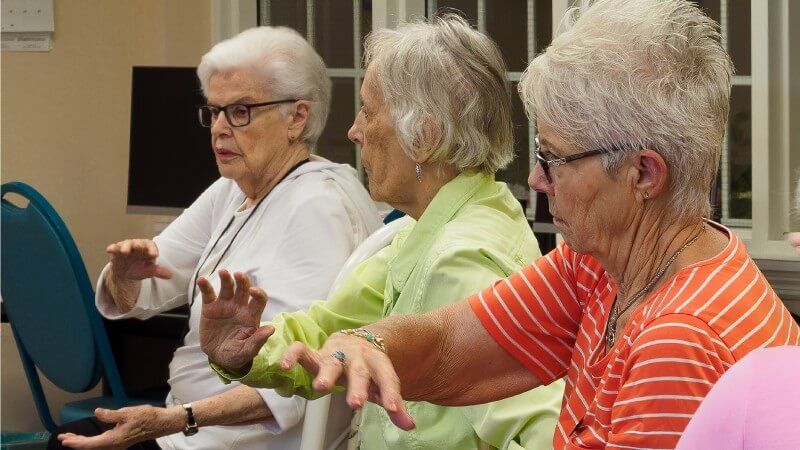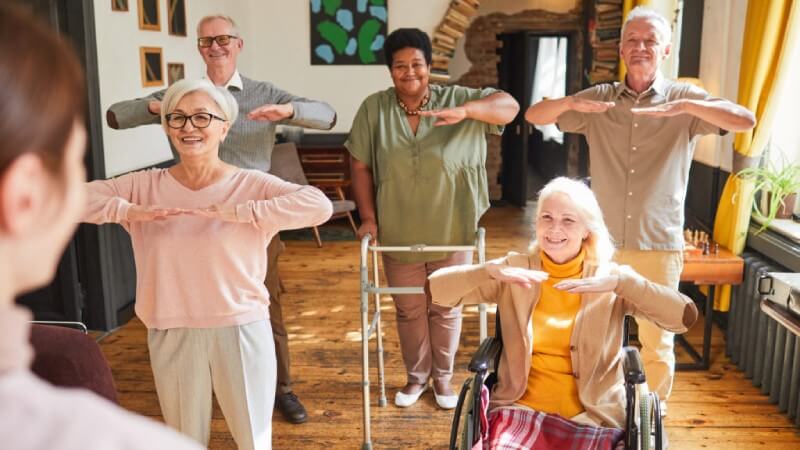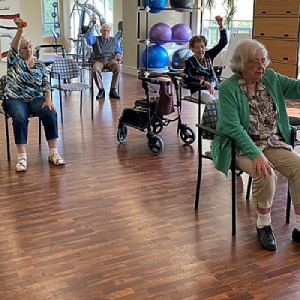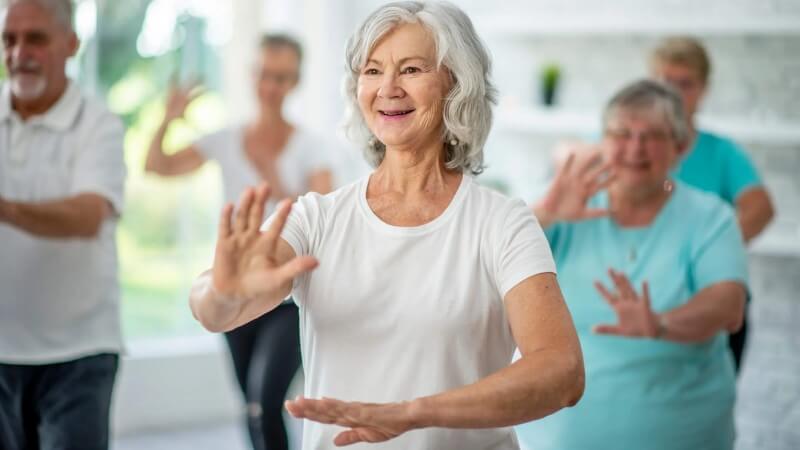Tai Chi for Seniors in Wheelchairs: A Comprehensive Guide to Health and Mobility
Tai chi, often referred to as “shadowboxing” in English, is a mesmerizing dance of slow, intentional movements that originated from the heart of China. Rooted deeply in Chinese martial arts, this practice has evolved over centuries, drawing inspiration from the harmonious balance of yin and yang.
With its origins tracing back to the Chen Village in Henan, tai chi has been influenced by both Taoist and Confucian philosophies, making it a blend of martial discipline and spiritual meditation.

The Importance of Physical Activity for Seniors
- Mental and Physical Well-being: As we age, maintaining both mental and physical health becomes paramount. Tai chi, with its gentle movements, offers a holistic approach to well-being, enhancing flexibility, strength, and mental clarity.
- Balance and Coordination: For seniors, the risk of falls can be a significant concern. Tai chi emphasizes balance, coordination, and grounding, helping to reduce the risk of such accidents.
Challenges Faced by Seniors in Wheelchairs
For seniors in wheelchairs, the challenges multiply. Limited mobility can lead to feelings of isolation, decreased physical activity, and potential health complications. However, the beauty of tai chi lies in its adaptability.
Adaptive Exercises: The Need of the Hour
- Seated Tai Chi: Recognizing the unique challenges faced by seniors in wheelchairs, adaptations like seated tai chi have emerged. This form allows individuals to experience the benefits of tai chi without the need to stand, making it accessible to all.
- Mental Benefits: Beyond the physical, tai chi offers a moving meditation, a chance to find inner peace and tranquility in the midst of life’s challenges.
Tai chi is more than just a form of exercise; it’s a journey of self-discovery, a dance of harmony, and a testament to the human spirit’s resilience.
The Transformative Power of Tai Chi for Wheelchair-Bound Seniors

Unlocking the Balance Within
For many, the image of tai chi conjures up scenes of serene parks and fluid movements. But did you know that this ancient Chinese martial art, often described as “meditation in motion,” offers a plethora of health benefits, especially for seniors in wheelchairs? Let’s delve into the myriad of advantages tai chi brings to this special group.
Improving Balance and Reducing Fall Risk
- Stability in Motion: One of the primary benefits of tai chi is its emphasis on balance. For seniors, especially those in wheelchairs, maintaining stability is crucial. Tai chi’s slow, deliberate movements train the body to find its center, reducing the risk of falls.
- Proprioception Boost: As we age, our ability to sense our body’s position in space diminishes. Tai chi enhances this sense, known as proprioception, helping seniors become more aware of their body and its movements.
Enhancing Flexibility and Strength
- Gentle Stretching: Unlike rigorous exercises that can strain the muscles, tai chi involves gentle stretching, improving flexibility without causing discomfort.
- Muscle Toning: The movements in tai chi, though subtle, engage various muscle groups. Regular practice can lead to improved muscle strength, even for those who remain seated.
Boosting the Immune System and Overall Well-being
- Holistic Health: Tai chi isn’t just about physical wellness. Its meditative nature can boost the immune system, enhancing the body’s ability to ward off illnesses.
- Harmony of Mind and Body: The synchronized breathing and movements in tai chi promote a sense of harmony, leading to overall well-being.
Mental Health Benefits
- Mindful Meditation: Tai chi is as much a mental exercise as it is physical. The focus on breathing and movement sharpens concentration and mindfulness.
- Elevated Mood: Regular practice can lead to increased happiness levels, thanks to the release of endorphins, the body’s natural mood lifters.
- Boosted Self-worth: Mastering the movements and sequences in tai chi can instill a sense of accomplishment, enhancing one’s self-worth and confidence.
In essence, tai chi offers a holistic approach to health, addressing both the physical and mental needs of seniors in wheelchairs. It’s a journey of self-discovery, balance, and rejuvenation, proving that limitations are merely stepping stones to greater achievements.
Embracing Tai Chi from the Comfort of a Chair
The Concept of Seated Tai Chi

Seated tai chi, a unique adaptation of the traditional form, is designed specifically for individuals who face challenges with standing or are recovering from medical treatments. This form ensures that everyone, regardless of their physical condition, can experience the myriad benefits of tai chi.
By focusing on hand-eye coordination and using tools like the tai chi stick, seated tai chi offers a focal point that enhances the practice.
Differences Between Traditional Tai Chi and Seated Tai Chi
- Movements and Postures: While traditional tai chi involves a series of standing postures and movements, seated tai chi is performed from a chair, focusing on upper body movements and coordination.
- Purpose and Focus: Seated tai chi is particularly beneficial for those with physical limitations, aiming to improve hand-eye coordination, prevent conditions like carpal tunnel syndrome, and enhance the flexibility and strength of the spine.
- Tools and Techniques: Some forms of seated tai chi, like the tai chi stick therapy, incorporate tools to aid in the practice, providing additional benefits like stimulating energy circulation in the fingers and wrists.
Choosing the Right Chair for Safety
- Sturdiness is Key: When practicing seated tai chi, it’s essential to choose a sturdy chair that offers stability and support, ensuring safety during the movements.
- Avoiding Wheels: Chairs with wheels can be unstable and pose a risk during practice. It’s best to opt for a stationary chair.
- Comfort Matters: A comfortable chair that provides proper back support will enhance the tai chi experience, allowing practitioners to focus on their movements without any discomfort.
Seated tai chi brings the ancient art of tai chi to those who might have felt it was out of reach. It’s a testament to the adaptability and inclusiveness of this practice, ensuring that everyone can find balance, peace, and health, no matter where they’re seated.
Seated Tai Chi: A Gentle Journey to Wellness
The Concept of Seated Tai Chi
Seated tai chi offers a gentle yet effective way to engage in this ancient practice, especially tailored for those who may have mobility challenges. Whether you’re a senior, recovering from an injury, or simply looking for a low-impact exercise, seated tai chi provides a perfect solution. It allows individuals to experience the calming and health-boosting benefits of tai chi without the need to stand.
Differences Between Traditional Tai Chi and Seated Tai Chi
- Focus on Upper Body: While traditional tai chi involves full-body movements, seated tai chi emphasizes upper body exercises, making it ideal for those with limited lower body mobility.
- Adapted Movements: Seated tai chi routines are carefully adapted to ensure they are effective and safe when performed from a chair. This includes modified hand movements, coordinated breathing, and gentle stretches.
- Holistic Approach: Just like its traditional counterpart, seated tai chi offers a holistic approach to well-being, focusing on the mind, body, and spirit.
Simple Seated Tai Chi Routines for Beginners
- Seated Tai Chi Exercises For Seniors – Easy to Follow (15 minutes): This routine is tailored for seniors, emphasizing gentle movements that can be easily followed. It’s a great starting point for those new to tai chi.
- Tai Chi Warmup in Chair (14 minutes): A warmup is essential to prepare the body for the exercises ahead. This 14-minute routine ensures that the muscles are warmed up, reducing the risk of strains.
- Tai Chi Shibashi Full 18 Movements Seated (7 minutes): This shorter routine focuses on the Shibashi set of movements, offering a comprehensive yet quick tai chi experience.
Importance of Choosing a Sturdy Chair for Safety
- Safety First: When practicing seated tai chi, it’s crucial to use a sturdy and stable chair. This ensures that you can focus on the movements without worrying about tipping over.
- Comfort is Key: A comfortable chair with proper back support will enhance the tai chi experience, allowing you to relax and immerse yourself in the practice.
In essence, seated tai chi brings the rejuvenating power of tai chi to everyone, regardless of their physical capabilities. It’s a testament to the adaptability of this ancient art, ensuring that everyone can embark on a journey of wellness and tranquility.
Safety First: Embracing Tai Chi with Care
Going Slow and Avoiding Pain or Injury Tai chi, with its graceful and fluid movements, might appear effortless, but like any form of exercise, it requires attention to detail and a mindful approach. Especially for beginners, it’s essential to:

- Pace Yourself: Start with shorter sessions and gradually increase the duration as you become more comfortable.
- Listen to Your Body: If a movement causes discomfort or pain, it’s a sign to stop and reassess. Remember, tai chi should feel therapeutic, not painful.
Modifying Exercises to Suit Individual Physical Conditions
Every individual is unique, and so is their physical condition. When practicing tai chi, especially the seated version, it’s crucial to:
- Seek Expert Guidance: An experienced instructor can offer modifications tailored to your needs, ensuring you reap the benefits without any risk.
- Be Open About Your Health: Inform your instructor about any health conditions or concerns you might have. This transparency allows for a safer and more effective practice.
Recognizing and Respecting One’s Limits
While tai chi is about pushing boundaries and exploring one’s potential, it’s equally important to recognize and respect one’s limits. Here’s how:
- Stay Mindful: Be aware of how your body responds to each movement. If something feels off, take a break.
- It’s Okay to Say No: If a particular movement or sequence doesn’t feel right, it’s okay to skip it. Tai chi is about harmony, and forcing oneself can disrupt that balance.
Importance of Choosing a Sturdy Chair for Safety
For those practicing seated tai chi, the chair becomes an integral part of the experience. Hence:
- Opt for Stability: A chair without wheels, with a firm seat and backrest, is ideal.
- Test Before You Start: Before beginning your session, ensure the chair is stable and placed on a non-slip surface.
While tai chi offers a plethora of benefits, safety should always be the priority. By being mindful, seeking expert guidance, and listening to one’s body, one can embark on a fulfilling and safe tai chi journey.
Dive Deeper: Resources and Support for Your Tai Chi Journey

Recommended Videos and Online Classes
Embarking on the tai chi journey is made easier with a plethora of online resources. From beginner tutorials to advanced sequences, the digital world offers a treasure trove of knowledge. Some noteworthy mentions include:
- YouTube Channels: Many experienced tai chi practitioners share their expertise through video tutorials, making it a valuable resource for visual learners.
- Tai Chi for Health Institute: Dr. Paul Lam’s Tai Chi for Health Institute offers a range of programs tailored for specific health conditions, including arthritis, diabetes, and more.
Finding Local Tai Chi Instructors Experienced with Seniors in Wheelchairs
While online resources are invaluable, nothing beats the hands-on guidance of a seasoned instructor. Here’s how to find one:
- Local Senior Centers: Many senior centers offer tai chi classes, and some might even have instructors experienced with wheelchair-bound seniors.
- Tai Chi for Health Institute’s Instructor Directory: The Tai Chi for Health Institute provides a directory of board-certified instructors who have undergone rigorous training and certification.
Joining Online Communities and Forums for Support and Advice
The tai chi community is vast and welcoming. By joining online forums and communities, you can:
- Share Experiences: Discuss your journey, challenges, and milestones with fellow enthusiasts.
- Seek Advice: Whether you’re facing a hurdle in your practice or need recommendations for resources, the community is always ready to help.
- Stay Updated: With the ever-evolving world of tai chi, online communities can be a great way to stay abreast of the latest techniques, research, and events.
While the path of tai chi is deeply personal, you’re never alone on this journey. With the right resources and a supportive community, you’re well on your way to reaping the myriad benefits of this ancient art.
FAQs
What is tai chi and how does it benefit seniors?
Tai chi, often referred to as “taiji” in Chinese, is an internal Chinese martial art practiced for both self-defense and health benefits. Known for its slow, intentional movements, tai chi is popular worldwide as a form of gentle exercise and moving meditation. It offers numerous benefits to mental and physical health, making it especially suitable for seniors. Practicing tai chi can help in relieving stress, improving posture, encouraging circulation, and maintaining flexibility. Moreover, it’s a low-stress training method, making it ideal for seniors to enhance their overall well-being.
How is seated tai chi different from traditional tai chi?
Seated tai chi is a modified version of traditional tai chi designed for individuals who may have mobility issues or cannot stand for extended periods. While traditional tai chi involves movements that require standing and shifting weight between legs, seated tai chi allows practitioners to perform similar movements while seated, ensuring they still reap the benefits of the exercise without the need for standing.
Can tai chi help with specific conditions like arthritis or Parkinson’s?
Yes, tai chi has been promoted for treating various ailments, including arthritis and Parkinson’s. Clinical studies have explored its effects on specific diseases and health conditions. For instance, tai chi has shown positive results in fall prevention and overall mental health for older individuals. Organizations like the Parkinson’s Foundation and Diabetes Australia support tai chi for its potential health benefits. However, it’s essential to consult with a healthcare professional before starting tai chi as a treatment for specific conditions.
How often should seniors practice tai chi?
The frequency of practicing tai chi varies based on individual preferences and physical conditions. However, consistent practice, such as 2-3 times a week, can offer noticeable benefits. Some practitioners even incorporate tai chi into their daily routine to maximize its advantages.
Are there any risks associated with tai chi for seniors in wheelchairs?
Tai chi is generally considered a safe and low-impact exercise. For seniors in wheelchairs, seated tai chi is an excellent alternative to traditional forms. It allows them to experience the benefits of tai chi without the need to stand. However, like any exercise, it’s crucial to ensure that movements are performed correctly to avoid strain or injury. It’s always a good idea to consult with a trained instructor or healthcare professional before starting a new exercise regimen.
